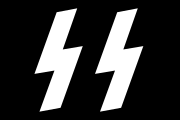Arajs Kommando
The Arajs Kommando (also: Sonderkommando Arajs), led by SS-Sturmbannführer Viktors Arājs, was a unit of Latvian Auxiliary Police (German: Lettische Hilfspolizei) subordinated to the Nazi Sicherheitsdienst (SD). It was one of the more well-known and notorious killing units during the Holocaust.
Formation
After the entry of the Einsatzkommando into the Latvian capital[1] contact between Viktors Arājs and Brigadeführer Walter Stahlecker was established on 1 July 1941. Stahlecker instructed Arājs to set up a commando that obtained an official name Latvian Auxiliary Security Police or Arajs Kommando.[2] The group was composed of students and former officers of far-right wing orientation. All of the Arajs Kommando members were volunteers, and free to leave at any time.[2] The following day on 2 July, Stahlecker revealed to Arājs that his commando had to unleash a pogrom that looked spontaneous.[3]
Activities
The Arajs Kommando unit actively participated in a variety of Nazi atrocities, including the killing of Jews, Roma, and mental patients, as well as punitive actions and massacres of civilians along Latvia's eastern border with the Soviet Union.[2] The Kommando killed around 26,000 Jews in total.[4] Most notably, the unit took part in the mass execution of Jews from the Riga ghetto, and several thousand Jews deported from Germany, in the Rumbula massacre of November 30 and December 8, 1941. Some of the commando's men also served as guards at the Salaspils concentration camp.[5]
As can be seen in contemporary Nazi newsreels—part of a documentation campaign to create the image that the Holocaust in the Baltics was a local, and not Nazi-directed activity—the Arajs Kommando figured prominently in the burning of Riga's Great (Choral) Synagogue on 4 July 1941. Commemoration of this event has been chosen for marking Holocaust Memorial Day in present-day Latvia.
The unit numbered about 300–500 men during the period that it participated in the killing of the Latvian Jewish population, and reached up to 1,500 members at its peak at the height of its involvement in anti-partisan operations in 1942. In the final phases of the war, the unit was disbanded and its personnel transferred to the Latvian Legion.
Persecution


After successfully hiding in West Germany for several decades after the war, Viktors Arājs was eventually arrested, tried, and imprisoned for his crimes.
More recently, the governments of Canada, the United States, the United Kingdom, and Australia were involved in the attempt to extradite Konrāds Kalējs, a former officer of the Arajs Kommando,[6] to Latvia for trial on charges of genocide. Kalējs died in 2001 in Australia before the extradition could proceed, maintaining his innocence to the end, stating that he was fighting Russia on the Eastern Front or studying at university when the slaughter of Jews took place in 1941. Latvian Holocaust historian A. Ezergailis estimates about a third of the Arājs Kommando, 500 of a maximum of around 1,500 total members, actively participated in the killings of Jews, and claimed that one cannot be convicted of crimes against humanity based solely on membership in an organization.[7]
See also
- Herberts Cukurs, a member of the Arajs Kommado, assassinated by Mossad in 1965
References
- ↑ Breitman, Richard (Sep 1991). "Himmler and the 'Terrible Secret' among the Executioners". Journal of Contemporary History. Sage Publications. 26 (3/4): 431–451. doi:10.1177/002200949102600305. JSTOR 260654.
- 1 2 3 Ruth Bettina Birn and Volker Riess. "Revising the Holocaust". The Historical Journal, Vol. 40, No. 1 (Mar., 1997), pp. 195-215. Published by: Cambridge University Press. Stable URL: http://www.jstor.org/stable/3020959
- ↑ Angrick, Andrej; Klein, Peter (2009). The "Final Solution" in Riga: Exploitation and Annihilation, 1941-1944. Volume 14 of Studies on War and Genocide. pp. 65–70. ISBN 9781845456085.
- ↑ Andrew Ezergailis (1996). The Holocaust in Latvia, 1941-1944. Historical Institute of Latvia, Riga ; United States Holocaust Memorial Museum; Washington, DC. OCLC 33403580.
- ↑ Strods, Heinrihs (2000). "Salaspils koncentrācijas nometne (1944. gada oktobris – 1944. gada septembris". Yearbook of the Occupation Museum of Latvia (in Latvian). 2000: 87–153. ISSN 1407-6330.
- ↑ "Konrad Kalejs: Target for Nazi hunters.". BBC News. 2000-01-03.
- ↑ Kalejs Not Necessarily Implicated, Reuters News Service, filed January 13, 2000, Canberra
Further reading
| Wikimedia Commons has media related to The Holocaust in Latvia. |
- Lumans, Valdis O. (2006). Latvia in World War II. World War II—The Global, Human, and Ethical Dimension 11. New York: Fordham University Press. ISBN 978-0-8232-2627-6. OCLC 64595899.
- Angrick, Andrej; Klein, Peter (2006). Die "Endlösung" in Riga: Ausbeutung und Vernichtung 1941–1944 (in German). Darmstadt: Wissenschaftliche Buchgesellschaft. ISBN 3-534-19149-8. OCLC 69983159.
- Foreign Ministry of Latvia: The Holocaust in German-Occupied Latvia
